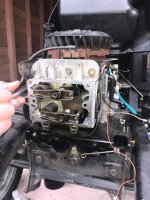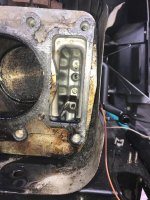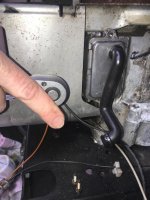You are using an out of date browser. It may not display this or other websites correctly.
You should upgrade or use an alternative browser.
You should upgrade or use an alternative browser.
Export thread
B&S Diamond I/C 15.5HP Repair / rebuild
#1
G
geertv
G
geertv
Hi, newbie in engine mechanics trying to repair the engine of an old garden tractor (15 year old).
The engine was starting fine, but after 20-30 seconds starts smoking extremely (burning oil). It keeps running pretty well, but you hear RPM isn't very stable, oil is not over-filled.
After inspection we see oil in air filter box and carburator, and it also leaked oil under the cylinder head.
I've read it can be a blown gasket with this engines so we opened it up a little more... Removed the oil, spark plug (pretty black) and the OHV cap (don't know what's the right name), there was still a bit oil in it but suppose thats normal. Then we opened the cylinder head, first remark the piston was very black and we do see some cracks in the gasket.
Here some images:


What do you guys think, would that have been the issue ? Now it's open so far, anything else that should be replaced ?
Also removed breather tube which is open but als contains oil, can the cap also be removed as it seems to be stuck:

Don't know this can just be removed ?
So, here we are now... any tips welcome
The engine was starting fine, but after 20-30 seconds starts smoking extremely (burning oil). It keeps running pretty well, but you hear RPM isn't very stable, oil is not over-filled.
After inspection we see oil in air filter box and carburator, and it also leaked oil under the cylinder head.
I've read it can be a blown gasket with this engines so we opened it up a little more... Removed the oil, spark plug (pretty black) and the OHV cap (don't know what's the right name), there was still a bit oil in it but suppose thats normal. Then we opened the cylinder head, first remark the piston was very black and we do see some cracks in the gasket.
Here some images:


What do you guys think, would that have been the issue ? Now it's open so far, anything else that should be replaced ?
Also removed breather tube which is open but als contains oil, can the cap also be removed as it seems to be stuck:

Don't know this can just be removed ?
So, here we are now... any tips welcome
#2
B
bertsmobile1
B
bertsmobile1
yes the head gasket is blown
Replace it
Buy two because they blow all of the time
Also look into installing a tap in the fuel line as hydrolocking is a big cause of these gaskets going bad
Give the head a light lap on a sheet of glass with some wet & dry soaked in Kerro
It is not flat , B & S deliberately mill it rough so it holds the gasket in place
The Stens aluminium gaskets are a lot better than the B & S gaskets
The tube is the crankcase breathee reconnect it as the engine will not run properly if it is not connected and the side of the engine will get very oily & thus dirty which affects the cooling
Replace it
Buy two because they blow all of the time
Also look into installing a tap in the fuel line as hydrolocking is a big cause of these gaskets going bad
Give the head a light lap on a sheet of glass with some wet & dry soaked in Kerro
It is not flat , B & S deliberately mill it rough so it holds the gasket in place
The Stens aluminium gaskets are a lot better than the B & S gaskets
The tube is the crankcase breathee reconnect it as the engine will not run properly if it is not connected and the side of the engine will get very oily & thus dirty which affects the cooling
#3
G
geertv
There is a tap in the fuel line, it has always been there, and we close it after usage.
I suppose the tube leaks oil to the airfilter due to the crack which causes pressure, right (try to understand exaclty what goes wrong) ? But why does it somke like hell, is it also sucking oil in the cylinder ?
Would you replace anything else except the gaskets now it's open ?
If I am correct, only issue might be I need special tool to measure distance between the valve caps and the rocker ? Or is there another way to mount it again ?
G
geertv
Many thanks for your help and confirming blown gasket.yes the head gasket is blown
Replace it
Buy two because they blow all of the time
Also look into installing a tap in the fuel line as hydrolocking is a big cause of these gaskets going bad
Give the head a light lap on a sheet of glass with some wet & dry soaked in Kerro
It is not flat , B & S deliberately mill it rough so it holds the gasket in place
The Stens aluminium gaskets are a lot better than the B & S gaskets
The tube is the crankcase breathee reconnect it as the engine will not run properly if it is not connected and the side of the engine will get very oily & thus dirty which affects the cooling
There is a tap in the fuel line, it has always been there, and we close it after usage.
I suppose the tube leaks oil to the airfilter due to the crack which causes pressure, right (try to understand exaclty what goes wrong) ? But why does it somke like hell, is it also sucking oil in the cylinder ?
Would you replace anything else except the gaskets now it's open ?
If I am correct, only issue might be I need special tool to measure distance between the valve caps and the rocker ? Or is there another way to mount it again ?
#4

sgkent
sgkent
maybe crankcase pressure from blown head gasket that is pushing oil thru breather into carb / manifold.
#5
B
bertsmobile1
B
bertsmobile1
The tube vents the crankcase into the carburettor
Excessive pressure in the crankcase caused by the leaking gasket forces oil fume into the carburettor causing the smoke
The engine will normally knock a little when you first engage the deck, and when you turn the engine off
Some time it will blow a little black smoke as well when the PTO is engaged
You will need a tension wrench to tighten the head bolts and note the torque is in INCH pounds not foot pounds like a car head so divide by 12 as very few tension wrenches are marked in inch pounds
I use a 6" long one to avoid over tightening .You will also need a set of feeler gauges, a torx spanner & a metric ( 10mm ) spannar to set the valve lash
Note that the grub screw ( torx head ) is the locking device & the outer nut is the adjustment , people often get it backwards because that is how cars work.
Pull the pushrods out, check they are strait & reverse them when you put them back in as they rub on the guide blocks and wear thin
If they look really worn replace then they are only about $ 10 a piece .
I fit 2 steel ones for this reason as the aluminium ones will wear thin & bend .
There are hundreds of you tube videos about doing this but watch a few to get a feel for it.
Donny Boy , Taryl, steves Saloon are all recommended viewing .
Clean the worst of the carbon off the piston top & head but do not touch the ring of carbon around the bore .
Does not have to be spotless you are not doing open heart opperations in there
The B & S manual is on line & if you are lucky some one will post a link to a copy
If you are unsure about anything then ask .
Excessive pressure in the crankcase caused by the leaking gasket forces oil fume into the carburettor causing the smoke
The engine will normally knock a little when you first engage the deck, and when you turn the engine off
Some time it will blow a little black smoke as well when the PTO is engaged
You will need a tension wrench to tighten the head bolts and note the torque is in INCH pounds not foot pounds like a car head so divide by 12 as very few tension wrenches are marked in inch pounds
I use a 6" long one to avoid over tightening .You will also need a set of feeler gauges, a torx spanner & a metric ( 10mm ) spannar to set the valve lash
Note that the grub screw ( torx head ) is the locking device & the outer nut is the adjustment , people often get it backwards because that is how cars work.
Pull the pushrods out, check they are strait & reverse them when you put them back in as they rub on the guide blocks and wear thin
If they look really worn replace then they are only about $ 10 a piece .
I fit 2 steel ones for this reason as the aluminium ones will wear thin & bend .
There are hundreds of you tube videos about doing this but watch a few to get a feel for it.
Donny Boy , Taryl, steves Saloon are all recommended viewing .
Clean the worst of the carbon off the piston top & head but do not touch the ring of carbon around the bore .
Does not have to be spotless you are not doing open heart opperations in there
The B & S manual is on line & if you are lucky some one will post a link to a copy
If you are unsure about anything then ask .
#6
G
geertv
G
geertv
Indeed, I think a lot of oil go's via the breather into the carb...
So, nothing else to change ? That's great news... learned a lot !
Someone knows where i can find the valve clearances for this engine ? And the torque for the cylinder head ?
Then I can close it and test
So, nothing else to change ? That's great news... learned a lot !
Someone knows where i can find the valve clearances for this engine ? And the torque for the cylinder head ?
Then I can close it and test
#8

StarTech
StarTech
IN .003-.005
EX .005-.007
Original head torque was 220 in-lbs. Briggs increased it to 250 in lbs (20.8 ft-lbs (I use 21 ft-lbs)) using three stage step torque. (7, 14, and finally 21)
Torque head bolts per service manual shown sequence.
EX .005-.007
Original head torque was 220 in-lbs. Briggs increased it to 250 in lbs (20.8 ft-lbs (I use 21 ft-lbs)) using three stage step torque. (7, 14, and finally 21)
Torque head bolts per service manual shown sequence.
#9

gamma_ray
Why should the carbon ring around the bore be left? Is it to prevent any lip from damaging the rings at TDC?
Thanks.
gamma_ray
Hello,The tube vents the crankcase into the carburettor
Excessive pressure in the crankcase caused by the leaking gasket forces oil fume into the carburettor causing the smoke
The engine will normally knock a little when you first engage the deck, and when you turn the engine off
Some time it will blow a little black smoke as well when the PTO is engaged
You will need a tension wrench to tighten the head bolts and note the torque is in INCH pounds not foot pounds like a car head so divide by 12 as very few tension wrenches are marked in inch pounds
I use a 6" long one to avoid over tightening .You will also need a set of feeler gauges, a torx spanner & a metric ( 10mm ) spannar to set the valve lash
Note that the grub screw ( torx head ) is the locking device & the outer nut is the adjustment , people often get it backwards because that is how cars work.
Pull the pushrods out, check they are strait & reverse them when you put them back in as they rub on the guide blocks and wear thin
If they look really worn replace then they are only about $ 10 a piece .
I fit 2 steel ones for this reason as the aluminium ones will wear thin & bend .
There are hundreds of you tube videos about doing this but watch a few to get a feel for it.
Donny Boy , Taryl, steves Saloon are all recommended viewing .
Clean the worst of the carbon off the piston top & head but do not touch the ring of carbon around the bore .
Does not have to be spotless you are not doing open heart opperations in there
The B & S manual is on line & if you are lucky some one will post a link to a copy
If you are unsure about anything then ask .
Why should the carbon ring around the bore be left? Is it to prevent any lip from damaging the rings at TDC?
Thanks.
#10

VRR.DYNDNS>BIZ
VRR.DYNDNS>BIZ
this statement is fact of the blue smoke with a blown gasket.maybe crankcase pressure from blown head gasket that is pushing oil thru breather into carb / manifold.
#11
B
bertsmobile1
The lip of carbon around the top of the bore goes a long way to alleviating the pressure & heat that is almost instantly applied to the rings .
So unless you are removing the piston you leave the carbon ring alone
Professional mechanics use a tool called a Ridge Reamer to clean the carbon ring off when removing pistons and it is just about the most expensive tool I have particularly when you consider it gets used once or twice a year at best .
The absence of the carbon ring was one of the big problems to overcome when developeing hydrogen powered engines because there is no carbon build up to protect the top ring so that required a total redesign of the piston rings and some engines now use 4 rings & / or a double thickness and deeper radial depth top ring .
B
bertsmobile1
The rings take a beating from the burning fuelHello,
Why should the carbon ring around the bore be left? Is it to prevent any lip from damaging the rings at TDC?
Thanks.
The lip of carbon around the top of the bore goes a long way to alleviating the pressure & heat that is almost instantly applied to the rings .
So unless you are removing the piston you leave the carbon ring alone
Professional mechanics use a tool called a Ridge Reamer to clean the carbon ring off when removing pistons and it is just about the most expensive tool I have particularly when you consider it gets used once or twice a year at best .
The absence of the carbon ring was one of the big problems to overcome when developeing hydrogen powered engines because there is no carbon build up to protect the top ring so that required a total redesign of the piston rings and some engines now use 4 rings & / or a double thickness and deeper radial depth top ring .
#12
S
slomo
S
slomo
Clean the block and cooling fins. In the pic where the push rods live, looks like steel wool slash grass and dirt around the cooling fins. Dirty fins cause over heats. Block and fins should look like a new engine. This is a yearly maintenance item in your engine manual.
#13
G
geertv
G
geertv
Replaced the gasket and set the valve clearance. After mounting everything again, she runs like a charm !
Many thanks for all help, this was my first gasket repalcement
Many thanks for all help, this was my first gasket repalcement
#14
S
slomo
S
slomo
Good news you got her going again.
Hope you lapped/sanded/trued up the head and block area where the gasket sits. Piece of plate glass and some 220, 400 and 800 grit wet/dry paper. Every one I've seen has some warpage in them. Even engines that are not known to blow head gaskets. If you remove any head, check it out.
Hope you lapped/sanded/trued up the head and block area where the gasket sits. Piece of plate glass and some 220, 400 and 800 grit wet/dry paper. Every one I've seen has some warpage in them. Even engines that are not known to blow head gaskets. If you remove any head, check it out.
#15

gamma_ray
Thanks for your reply!
Gamma
gamma_ray
That makes sense. I wonder if CNG conversion vehicle have the same issue as the H2 engines, or is there a carbon buildup with burning CNG as well? I have a propane powered whose house generator and also a dual fuel "portable" generator, and your answer makes me wonder about those engines as well. I suppose there would still be a carbon deposit on those as well.The rings take a beating from the burning fuel
The lip of carbon around the top of the bore goes a long way to alleviating the pressure & heat that is almost instantly applied to the rings .
So unless you are removing the piston you leave the carbon ring alone
Professional mechanics use a tool called a Ridge Reamer to clean the carbon ring off when removing pistons and it is just about the most expensive tool I have particularly when you consider it gets used once or twice a year at best .
The absence of the carbon ring was one of the big problems to overcome when developeing hydrogen powered engines because there is no carbon build up to protect the top ring so that required a total redesign of the piston rings and some engines now use 4 rings & / or a double thickness and deeper radial depth top ring .
Thanks for your reply!
Gamma
#16
B
bertsmobile1
H2 engines can not do this because there is no carbon in the fuel in the first place
B
bertsmobile1
LPG engines will also build up a carbon ring although it will be smaller and take a lot longer to build upThat makes sense. I wonder if CNG conversion vehicle have the same issue as the H2 engines, or is there a carbon buildup with burning CNG as well? I have a propane powered whose house generator and also a dual fuel "portable" generator, and your answer makes me wonder about those engines as well. I suppose there would still be a carbon deposit on those as well.
Thanks for your reply!
Gamma
H2 engines can not do this because there is no carbon in the fuel in the first place

